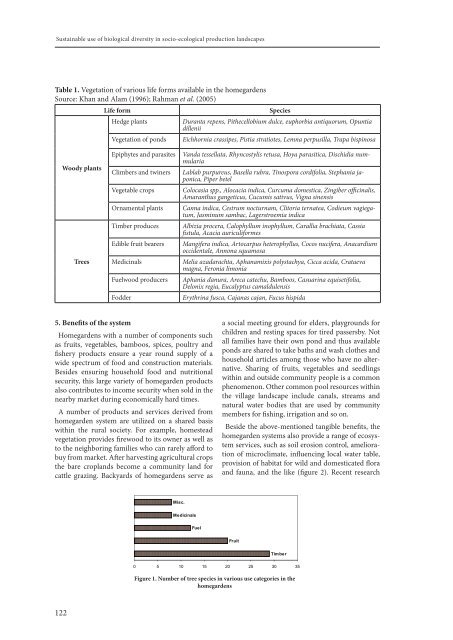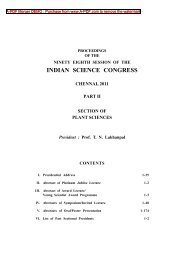sustainable use of biological diversity.pdf - India Environment Portal
sustainable use of biological diversity.pdf - India Environment Portal
sustainable use of biological diversity.pdf - India Environment Portal
You also want an ePaper? Increase the reach of your titles
YUMPU automatically turns print PDFs into web optimized ePapers that Google loves.
Sustainable <strong>use</strong> <strong>of</strong> <strong>biological</strong> <strong>diversity</strong> in socio-ecological production landscapes<br />
table 1. Vegetation <strong>of</strong> various life forms available in the homegardens<br />
Source: Khan and Alam (1996); Rahman et al. (2005)<br />
life form<br />
Species<br />
Hedge plants<br />
Duranta repens, Pithecellobium dulce, euphorbia antiquorum, Opuntia<br />
dillenii<br />
Vegetation <strong>of</strong> ponds Eichhornia crassipes, Pistia stratiotes, Lemna perpusilla, Trapa bispinosa<br />
Woody plants<br />
trees<br />
Epiphytes and parasites<br />
Climbers and twiners<br />
Vegetable crops<br />
Ornamental plants<br />
Timber produces<br />
Edible fruit bearers<br />
Medicinals<br />
Fuelwood producers<br />
Fodder<br />
Vanda tessellata, Rhyncostylis retusa, Hoya parasitica, Dischidia nummularia<br />
Lablab purpureus, Basella rubra, Tinospora cordifolia, Stephania japonica,<br />
Piper betel<br />
Colocasia spp., Alocacia indica, Curcuma domestica, Zingiber <strong>of</strong>ficinalis,<br />
Amaranthus gangeticus, Cucumis sativus, Vigna sinensis<br />
Canna indica, Cestrum nocturnam, Clitoria ternatea, Codieum vagiegatum,<br />
Jasminum sambac, Lagerstroemia indica<br />
Albizia procera, Calophyllum inophyllum, Carallia brachiata, Cassia<br />
fistula, Acacia auriculiformes<br />
Mangifera indica, Artocarpus heterophyllus, Cocos nucifera, Anacardium<br />
occidentale, Annona squamosa<br />
Melia azadarachta, Aphanamixis polystachya, Cicca acida, Crataeva<br />
magna, Feronia limonia<br />
Aphania danura, Areca catechu, Bamboos, Casuarina equisetifolia,<br />
Delonix regia, Eucalyptus camaldulensis<br />
Erythrina fusca, Cajanas cajan, Fucus hispida<br />
5. benefits <strong>of</strong> the system<br />
Homegardens with a number <strong>of</strong> components such<br />
as fruits, vegetables, bamboos, spices, poultry and<br />
fishery products ensure a year round supply <strong>of</strong> a<br />
wide spectrum <strong>of</strong> food and construction materials.<br />
Besides ensuring ho<strong>use</strong>hold food and nutritional<br />
security, this large variety <strong>of</strong> homegarden products<br />
also contributes to income security when sold in the<br />
nearby market during economically hard times.<br />
A number <strong>of</strong> products and services derived from<br />
homegarden system are utilized on a shared basis<br />
within the rural society. For example, homestead<br />
vegetation provides firewood to its owner as well as<br />
to the neighboring families who can rarely afford to<br />
buy from market. After harvesting agricultural crops<br />
the bare croplands become a community land for<br />
cattle grazing. Backyards <strong>of</strong> homegardens serve as<br />
a social meeting ground for elders, playgrounds for<br />
children and resting spaces for tired passersby. Not<br />
all families have their own pond and thus available<br />
ponds are shared to take baths and wash clothes and<br />
ho<strong>use</strong>hold articles among those who have no alternative.<br />
Sharing <strong>of</strong> fruits, vegetables and seedlings<br />
within and outside community people is a common<br />
phenomenon. Other common pool resources within<br />
the village landscape include canals, streams and<br />
natural water bodies that are <strong>use</strong>d by community<br />
members for fishing, irrigation and so on.<br />
Beside the above-mentioned tangible benefits, the<br />
homegarden systems also provide a range <strong>of</strong> ecosystem<br />
services, such as soil erosion control, amelioration<br />
<strong>of</strong> microclimate, influencing local water table,<br />
provision <strong>of</strong> habitat for wild and domesticated flora<br />
and fauna, and the like (figure 2). Recent research<br />
Misc.<br />
Medicinals<br />
Fuel<br />
Fruit<br />
Timber<br />
0 5 10 15 20 25 30 35<br />
Number <strong>of</strong> species<br />
figure 1. number <strong>of</strong> tree species in various <strong>use</strong> categories in the<br />
homegardens<br />
122
















